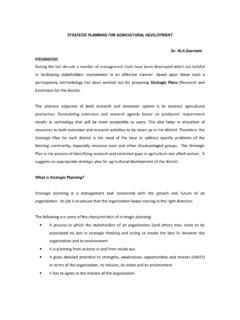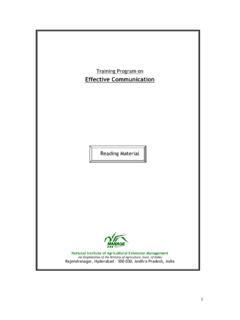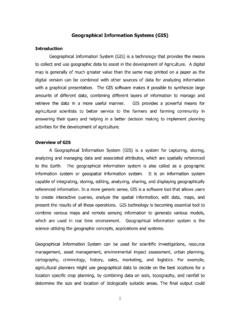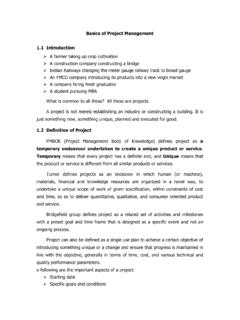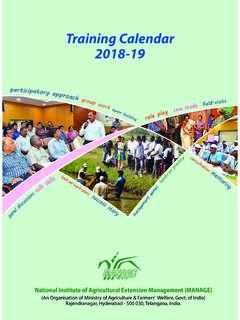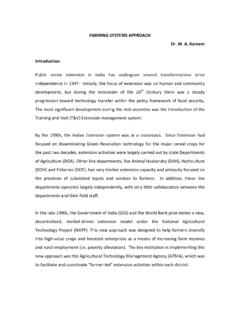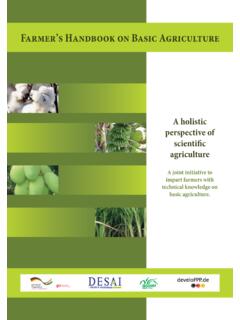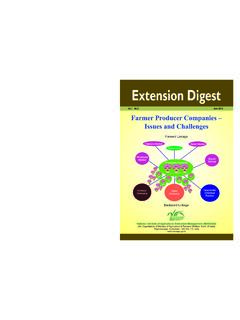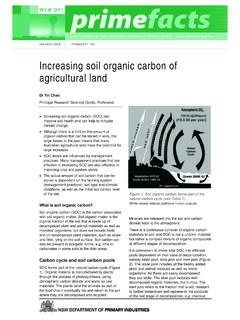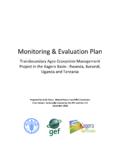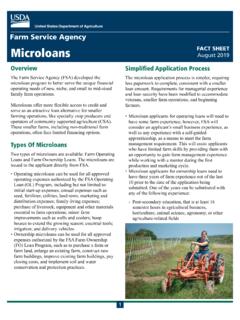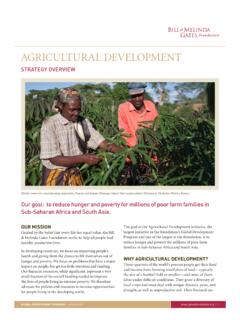Transcription of Supply Chain Management in Agriculture
1 Training programme on Supply Chain Management in Agriculture Reading Material NATIONAL INSTITUTE OF agricultural EXTENSION Management . An organisation of Ministry of Agriculture , Government of India Rajendranagar, Hyderabad 500 030. Tel. Nos. 040 4016702 706 : Fax 040 4015388. Website: CONTENT. 1. Integrated Agri- Supply Chain Management 03-17. 2. agricultural marketing scenario in India 18-23. 3. Supply Chain Management in Horticulture 24-40. 4. Supply Chain Management in dairy 41-40. 5. Supply Chain Management in Poultry 41- 45.
2 2. CHAPTER - 1. Integrated Agri- Supply Chain Management Supply chains are principally concerned with the flow of products and information between Supply Chain member organizations procurement of materials, transformation of materials into finished products, and distribution of those products to end customers. Today's information-driven, integrated Supply chains are enabling organizations to reduce inventory and costs, add product value, extend resources, accelerate time to market, and retain customers.
3 The real measure of Supply Chain success is how well activities coordinate across the Supply Chain to create value for consumers, while increasing the profitability of every link in the Supply Chain . In other words, Supply Chain Management is the integrated process of producing value for the end user or ultimate consumer. The Supply chains of different agricultural commodities in India, however, are fraught with challenges stemming from the inherent problems of the Agriculture sector. The agri- Supply Chain system of the country is determined by different sartorial issues like dominance of small/ marginal farmers, fragmented Supply chains, absence of scale economies, low level of processing/value addition, inadequacy of marketing infrastructure etc.
4 Early processing-based Supply Chain Management success included improved relationships between warehousing and transportation within companies as a result of reduced inventory and better response time to customer requests for products and services. Supply Chain Management then entered a logistics stage where other functional areas within companies joined forces to incorporate manufacturing, procurement, transportation, distribution, and marketing to effectively compete in the marketplace. This stage was aided by the use of telecommunications, electronic data interface, and other technological advances that made the transfer of information more transparent across the functional areas between companies.
5 3. Food Supply Chain Networks A processing-based and organised agri- Supply Chain functions as a part of a very complex network. Figure 1 depicts a generic Supply Chain at the organization level within the context of a complete Supply - Chain network. Each firm is positioned in a network layer and belongs to at least one Supply Chain , it usually has multiple (varying) suppliers and customers at the same time and over time. Fig- 1: Schematic Diagram of Supply Chain The advantages for Supply Chain members Individual suppliers, producers and marketers who are associated through a Supply Chain coordinate their value creating activities with one another and, in the process, create greater value than they can, when they operate independently.
6 Supply chains create synergies in one of three ways: i) They expand traditional markets beyond their original boundaries and thus increase sales volume for members;. ii) They reduce the delivered cost of products below the cost of competing chains and thus increase the gross margin for the working capital committed by members of the Chain ;. and iii) They target specific market segments with specific products and they differentiate the service, product quality or brand reputation of the products they deliver to these market 4.
7 Segments and thus increase consumer perception of delivered value. In this way, they allow Chain members to charge higher prices. Generally, Supply chains increase market contestability both at the producer end and at the consumer ends of the Chain . At the consumer end, chains compete primarily through price, differentiated products and services and differentiated terms of sale. At the producer end of the Chain , Supply chains compete with one another primarily for "producer affiliation". and core vendor commitments.
8 Components of an Agri Supply Chain Agribusiness, Supply Chain Management (SCM) implies managing the relationships between the businesses responsible for the efficient production and Supply of products from the farm level to the consumers to meet consumers' requirements reliably in terms of quantity, quality and price. In practice, this often includes the Management of both horizontal and vertical alliances and the relationships and processes between firms . Agri- Supply chains are economic systems which distribute benefits and apportion risks among participants.
9 Thus, Supply chains enforce internal mechanisms and develop Chain wide incentives for assuring the timely performance of production and delivery commitments. They are linked and interconnected by virtue of shared information and reciprocal scheduling, product quality assurances and transaction volume commitments. Process linkages add value to agricultural products and require individual participants to co- ordinate their activities as a continuous improvement process. Costs incurred in one link in the Chain are determined in significant measure by actions taken or not taken at other links in the Chain .
10 Extensive pre-planning and co-ordination are required up and down the entire Chain to affect key control processes such as forecasting, purchase scheduling, production and processing programming, sales promotion, and new market and product launches etc. Following are the components of an organised agri- Supply Chain : 1. Procurement or sourcing 2. Logistic Management a. Transportation b. Material Management c. On the premise of supplying mostly from production not stock 5. d. Warehousing e. Logistics Network modeling 3.
